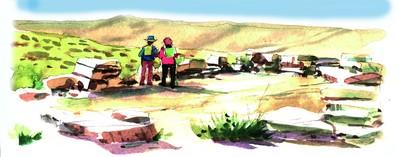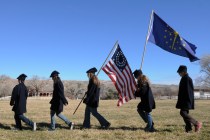Piute Canyon still draws dedicated explorers
The stone ruins of old Fort Piute overlook a spring and vegetation-filled canyon at the eastern edge of the Mojave National Preserve. One of the few sources of reliable water in the Mojave Desert, Piute Spring and its half-mile long stream drew overland travelers for many centuries. Today, the remote site draws only dedicated hikers and back road explorers seeking glimpses of the past.
Visitors approach the canyon and fort on foot, either from the west on roads within the Mojave National Preserve or from U.S. 95 to the east on obscure side roads. Use high-clearance vehicles or those with four-wheel drive.
To reach Piute Canyon from U.S. 95, drive a little more than six miles south of the junction with Highway 163, the road to Laughlin. Watch for a graded road heading west. Follow it about seven miles to a power line road, where you turn north for about a mile and a half. Watch for two rock cairns marking the turnoff onto the canyon road, a very rough track. You may have to park and walk the two miles to the ruins of the 1800s fort near the mouth of the canyon.
Visitors within the preserve follow a graded utility road from the junction of Cedar Canyon Road and Lanfair Road east nine and a half miles to a smaller road leading to a corral. North of the cattle guard, look for rock cairns marking two different foot paths to Piute Canyon, a trip totaling about six and a half miles round-trip. Young people from the California Conservation Corps spent time improving the rough canyon trail last year.
Natives of prehistory visited frequently. Hunters stalked the wildlife attracted to the water and vegetation. Farmers diverted the stream into irrigation channels for their tiny patches of corn, beans, squash and cotton. Seasonally, they gleaned a variety of natural foods and plant products. They left scattered petroglyphs on boulders to mark the importance of the oasis.
The site witnessed a parade led by native groups who established foot trails for long distance trading routes long before the arrival of white settlers. When a Spanish exploration party including Father Francisco Garces ventured into the area seeking a route to the coast in the 1700s, local Mojave and neighboring Chemehueve tribes assisted and accompanied them. The natives met the first exploring fur trappers cordially in the 1820s. Later relations with encroaching whites turned much less hospitable.
The ancient route past Piute Creek carried no stranger travelers than the experimental camel caravan led across the desert in 1857-58 by soldier-surveyor-explorer Edward F. Beale. Camels subsequently served as beasts of burden in arid parts of the West for several decades in the late 1800s, including Nevada.
Although Beale and his camels encountered no hostile natives, an emigrant train across the Colorado River in Arizona was massacred in the fall of 1858. The incident led to the 1859 construction of Camp Colorado, later Fort Mojave, on the river 22 miles east of Piute Canyon. That year, hostiles also attacked a military expedition passing through the canyon. In 1859-60, the army established a chain of redoubts across the Mojave Desert. The first one west of Fort Mojave at Painter Creek was first called Fort Beale, but later renamed Fort Piute. Outposts to the west about 20 miles apart included forts at Rock Spring and Soda Spring.
Fort Piute housed 18 soldiers and their officers. Ruins of rock-walled buildings, passageways and corrals remain. The thick stone walls contained defensive rifle ports and metal deflecting shields. The larger of two buildings contained three rooms and a fireplace within walls measuring 25 by 60 feet.
The army manned the fort until the outbreak of the Civil War in 1861. California Volunteers re-manned it in 1863. Returning in 1866, the army used it through 1868. Later, the post became a relay station for the overland mail where stagecoaches changed horse teams. The steep, rough section of government road through Piute Canyon often put passengers afoot, even the sick or wounded. When steamboats began to ply the Colorado River and railroads finally crossed the Mojave, the centuries-old trail became a nearly forgotten path.
Margo Bartlett Pesek's column appears on Sundays.






















